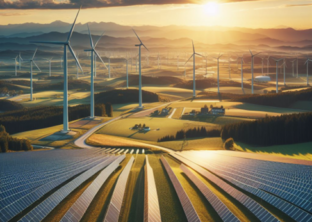Bio-based raw materials, biogas and biorefineries
The chemical industry in Germany is currently experiencing the worst crisis since the global economic crisis in 2009. In 2022, chemical production fell by about 12 percent compared to the previous year. This is a greater decline than during the global economic crisis. A further production decline of 8 percent is expected in 2023. Although optimism is slowly returning, the situation in the German chemical industry remains difficult and fragile.
Currently, it is assumed that the downturn has hit bottom, yet a dynamic upswing is not expected. As a production location, the European and particularly the German chemical industry is disadvantaged compared to other regions such as the USA or Asia due to high energy costs. It is unlikely that this problem will be solved in the near future. Energy-intensive basic chemicals are facing extinction in Germany or are in the process of being migrated to regions with lower energy costs. To defend its position in the global market, the German chemical industry must further increase its efforts and focus even more on innovation, efficiency and sustainability.
The development and use of new technologies is imperative for the transformation of the chemical industry towards a sustainable and climate-neutral, but also competitive industry. We are in the middle of the fourth and current stage of development of the chemical industry, Chemistry 4.0, which represents the digital transformation of the chemical industry aimed at improving efficiency, productivity, and sustainability, in the sense of a digital circular economy.
Sustainability is trending as more and more people have become aware that natural resources are finite and that the current lifestyle is not sustainable. However, as the latest report of the Intergovernmental Panel on Climate Change shows, accelerated climate and environment action is required, now even more so than in the past. As a key industry, the chemical industry plays an important role in our modern society and is the driving force behind the development of new materials and technologies.
On the other hand, the chemical industry also has a significant impact on the environment and climate change, as it often uses fossil and other unsustainable raw materials as feedstocks. To meet this challenge and make the transformation towards a climate-neutral industry, SVP has defined six important fields of action.

To kick off our new series of articles on the sustainable transformation of the chemical industry, we first turn our attention to bio-based feedstocks, biogas plants and biorefineries. To achieve a successful transformation away from a petroleum-based industry, we need to focus on non-fossil and recycled raw materials. The future belongs to sustainable and environmentally friendly solutions.
Biorefineries are a core element of the emerging bioeconomy. The concept of “biorefinery” aims at the long-term replacement of petroleum as an important raw material for the chemical industry and the development of a bio-based industry. Biorefining involves the conversion of biomass into various bio-based products and components for further use in different industries. By using renewable raw materials, the industry reduces its carbon footprint.
The use of the resulting bio-based products reduces the consumption of fossil raw materials. First-generation bio-based raw materials contain sugars and plant oils that occur in crops. Due to the use of these plant resources also for food production, their use is highly controversial (“tank or plate” discussion). It is therefore essential to turn to second-generation raw materials. These include waste streams from food production or the wood industry, lignocellulosic biomass or forestry crops and agricultural residues or agricultural waste. Specific non-food energy crops that can be grown on land unsuitable for food production are also of interest as feedstocks.
Biorefining includes upstream processes for pre-treatment, the actual conversion (fermentation) as well as downstream processes for the mechanical and thermal isolation of oils, fats, lignocellulose, proteins, starch, and sugar. These substances are used to produce food and animal feed, biofuels, bioplastics and building blocks for chemicals.

The great diversity in the composition of biomass as a feedstock for biorefineries leads to a range of different technological approaches and biorefinery concepts, such as sugar and starch biorefineries, vegetable oil and algal biorefineries, lignocellulosic biorefineries, synthesis gas biorefineries and biogas biorefineries.
Germany has recognised the potential of biorefineries and is at the forefront worldwide. According to the study “EU Biorefinery Outlook to 2030”, around 300 biorefineries in the EU already generate a turnover of several billion euros with bio-based products, from which, currently, 4.6 million tonnes of chemicals and materials are manufactured in Europe. By 2030, production could increase by another 1.1 to 3.1 million tonnes. The plants are mainly located in Central Europe, especially in Germany, France, the Benelux countries, and Northern Italy. In Germany, about 60 biorefineries are operational. One plant, currently in the spotlight, is the biorefinery of Europe’s largest paper producer UPM at the Leuna site.
From 2023 onwards, wood-based chemical feedstocks such as bio-monoethylene glycol (MEG) and bio-monopropylene glycol (MPG) are to be produced here. The raw material basis for an annual production capacity of 220,000 tonnes of chemicals will be regional hardwood and industrial wood that cannot be utilized, as well as sawmill residues. Around EUR 550 million was invested in the world’s first fully integrated wood-based biorefinery, which completely breaks down a single raw material and produces several intermediate and end products from it.
In the EU, the share of biorefineries that use forestry feedstocks is currently around 23 percent. However, agricultural feedstocks currently dominate with a share of 64 percent. In comparison, organic waste and marine sources such as algae are still playing a minor role.

Biorefineries will be an irreplaceable component of the circular bioeconomy, literally, a true circular economy in which substances can be recycled and refined again. In the future, biorefineries will probably turn into much smaller and decentralised units in order to be able to include biogas plants in the raw material utilisation, for example. There are many possibilities and approaches to further develop the “classic” agricultural biogas process into a biorefinery, or to integrate biogas production as a component of a biorefinery process.
In addition to biorefineries, biogas plants should also play a more important role again in the production of bio-based products in the future. A biogas plant is a facility that produces biogas by decomposing organic materials under anaerobic (oxygen-free) conditions. Biogas is a renewable energy source consisting mainly of methane and carbon dioxide. It can be used to generate electricity and heat or serve as a fuel for vehicles. The production of bio-based products for the chemical industry from methane in biogas plants currently plays a minor role.
According to the bioenergy association “Bundesverband Bioenergie e.V.” (BBE), there were a total of around 9,900 biogas plants in Germany in 2022 with an installed capacity of approximately 6,000 megawatts (MW). According to an estimate by the European Biogas Association (EBA), the number of biogas plants in Europe at the end of 2020 totalled about 17,000 plants with a combined installed capacity of more than 16,000 megawatts. Within Europe, most biogas plants are in Germany, Italy, France, and the UK. Similar to Europe, the German market for biogas plants has also stagnated in recent years, when looking at the development of the number of biogas plants. This is due to political changes and the increased promotion of other renewable energies such as solar and wind energy.

The market for biogas plants must see a renaissance, particularly if biogas is to be increasingly used as a feedstock for the production of bioplastics and other bio-based materials, and is to become the focus of the chemical industry once again. This would offer a number of advantages compared to fossil raw materials. On the one hand, it is a renewable raw material that can contribute to reducing dependence on fossil raw materials. On the other hand, it can help reduce greenhouse gas emissions, as the production of bio-based materials from biogas usually emits less carbon dioxide than the use of fossil raw materials.
SVP sees a need for action to invest more in the areas of biorefineries, biogas plants and the production of bio-based products, in order to be able to meet the challenges of the transformation towards a sustainable and climate-neutral chemical industry.

The use of biogas / biorefinery technologies as well as the use of biomass and organic waste offer a sustainable alternative to petroleum-based raw material sources. They help reduce raw material dependency, reduce the CO2 footprint of products, or the greenhouse gas emissions of the chemical industry, and establish an efficient circular economy. This is an important step towards achieving sustainability goals and addressing the challenges of climate change.
In the next article, my colleague, Dr. Hinz, will investigate the topic of hydrogen economy, an important topic for the chemical industry. In particular, he will discuss the importance of green hydrogen for sustainable production in the chemical industry and show the potentials and challenges associated with this technology.

Dr Volkhard Franke, Market Intelligence Senior Expert
Sources:
- European Biogas Association (EBA) www.europeanbiogas.eu;
- chverband Biogas www.biogas.org;
- EU biorefinery outlook to 2030: Studies on support to research and innovation policy in the area of biobased products and services. https://op.europa.eu/en/publication-detail/-/publication/7223cd2e-bf5b-11eb-a925-01aa75ed71a1;
- Map of biorefineries: https://knowledge4policy.ec.europa.eu/visualisation/chemical-material-biorefineries-eu_en; Bundesverband Bioenergie e.V. (BBE) www.bioenergie.de;
- UPM Biochemicals www.upmbiochemicals.com;
- GEA www.gea.com;
- Fachagentur Nachwachsende Rohstoffe (FNR) www.fnr.de;
- „Von der Biogasanlage zur Bioraffinerie – Perspektiven für zukünftige Biogasanlagenkonzepte“, Zeitschrift Energiewirtschaft (2018) 42, 235-256.







